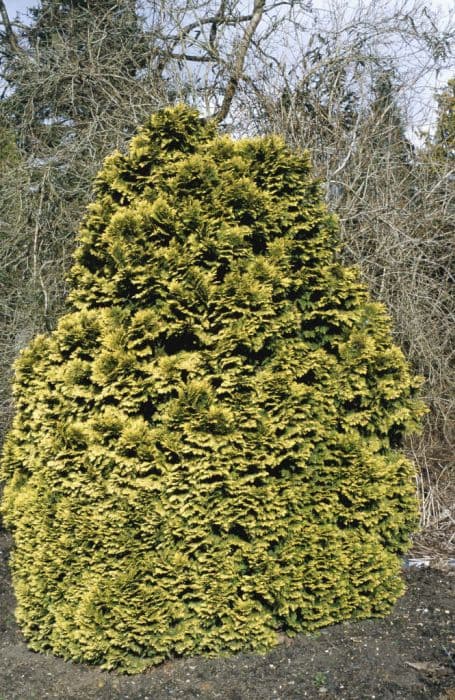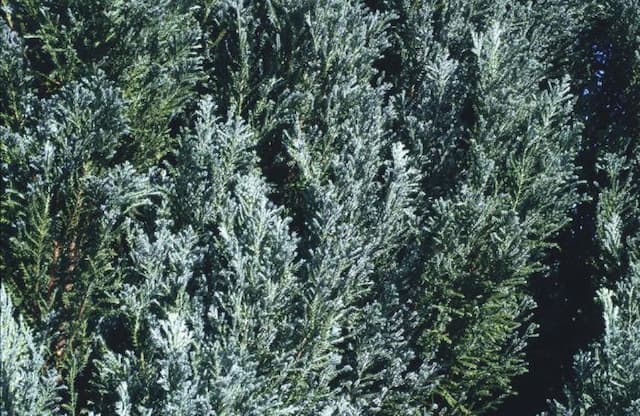Crippsii False Cypress Chamaecyparis obtusa 'Crippsii'

ABOUT
The Crippsii or Crippsii False Cypress is a striking evergreen noted for its lush golden-yellow foliage. This conical-shaped plant has a dense growth habit with fine, feathery leaves that are soft to the touch, giving it a graceful and delicate appearance. The foliage, particularly at the tips, exhibits a vibrant golden hue, which can brighten up any landscape setting. As the foliage matures deeper into the plant, it transitions to a rich green color, providing a beautiful contrast against the newer, lighter growth. The leaves are arranged in flat sprays that showcase an elegant fern-like texture, adding both volume and a soft visual quality to the plant. These sprays are gently curved, contributing to the Crippsii's overall fluffy and full appearance. The visual appeal is further enhanced when the plant is backlit by sunlight, which makes the golden foliage shimmer and gives the plant a radiant glow. As an ornamental plant, the Crippsii False Cypress is often used for its color and form in various garden settings, including hedges, standalone specimens, or as part of a conifer collection. Throughout the seasons, it retains its color and form, providing year-round interest in a garden landscape. Notably, the plant's eye-catching golden tints are more pronounced in full sun but will still maintain a pleasing appearance in light shade.
About this plant
 Names
NamesFamily
Cupressaceae
Synonyms
Crippsii Golden Hinoki Cypress, Crippsii False Cypress, Golden Hinoki False Cypress
Common names
Chamaecyparis obtusa 'Crippsii'.
 Toxicity
ToxicityTo humans
The Hinoki cypress (Chamaecyparis obtusa 'Crippsii') is generally not considered toxic to humans. However, like many plants, it could cause a mild stomach upset if ingested in large quantities. It is uncommon for people to eat parts of ornamental plants like the Hinoki cypress, so poisoning is rare. The most likely adverse reactions might be allergic skin reactions from handling the plant for sensitive individuals.
To pets
The Hinoki cypress is not listed as a toxic plant to pets, which includes dogs and cats. It is generally considered to be of low toxicity to animals. As with humans, ingestion of plant material by pets may result in gastrointestinal upset, such as vomiting or diarrhea if consumed in significant amounts. However, these instances are relatively uncommon due to the non-palatable nature of the plant. If a pet does ingest part of the plant and seems to be reacting poorly, consulting a veterinarian is advisable.
 Characteristics
CharacteristicsLife cycle
Perennials
Foliage type
Evergreen
Color of leaves
Green
Height
5-6 feet (1.5-1.8 meters)
Spread
4-5 feet (1.2-1.5 meters)
Plant type
Tree
Hardiness zones
5
Native area
Japan
Benefits
 General Benefits
General Benefits- Aesthetic Appeal: Chamaecyparis obtusa 'Crippsii', commonly known as the Crippsii False Cypress, adds visual interest to the landscape with its bright golden-yellow foliage and pyramidal shape.
- Low Maintenance: It requires minimal pruning and is relatively low maintenance once established, making it a suitable choice for those with limited gardening time.
- Drought Tolerance: Once established, the Crippsii False Cypress is tolerant of drought, reducing the need for regular watering.
- Evergreen Nature: Being an evergreen, it provides year-round color and structure to gardens, contrasting beautifully with deciduous plants.
- Wildlife Habitat: Offers shelter and nesting sites for birds and other wildlife, thereby supporting local biodiversity.
- Windbreak: Due to its dense growth, it can act as an effective windbreak or natural screen, providing privacy and reducing wind speed in garden settings.
- Soil Stabilization: Its root system helps to stabilize soil and prevent erosion on slopes or in areas prone to erosion.
- Adaptability: It is adaptable to a variety of soil types, although it prefers moist, well-drained soil, making it versatile for different garden conditions.
- Longevity: With a long lifespan, this plant can provide benefits for many years, making it a lasting addition to the landscape.
- Seasonal Interest: Although evergreen, it exhibits seasonal changes in color intensity, often brighter in the spring and summer, adding seasonal interest to the garden.
 Medical Properties
Medical PropertiesThis plant is not used for medical purposes.
 Air-purifying Qualities
Air-purifying QualitiesThis plant is not specifically known for air purifying qualities.
 Other Uses
Other Uses- Miniature Model Landscapes: Hinoki cypress can be pruned into small trees and shrubs to create realistic miniature landscapes for model train setups or architectural models.
- Traditional Japanese Crafts: Its fine-grained wood can be used in crafting traditional Japanese items such as geta sandals or small pieces of furniture, emphasizing its cultural significance.
- Wood Carving: The plant's wood, known for its pleasant scent and workability, is appreciated by woodcarvers for creating intricate sculptures and decorative items.
- Insect Repellent: Hinoki cypress wood chips or shavings are sometimes used in closets or drawers as a natural insect repellent to protect clothing and linen.
- Sound Absorption: Dried and processed foliage can be incorporated into sound-absorptive panels or tiles, exploiting its fibrous nature to improve room acoustics.
- Aquarium Decoration: Treated and safe pieces of hinoki cypress wood can serve as natural-looking decorations in aquariums, providing aesthetic value and hiding spots for fish.
- Bonsai Creation: The dense foliage and slow growth habit allow hinoki cypress to be cultivated as bonsai, providing hobbyists with a living art form to train and shape.
- Photography Subjects: With its distinct conical shape and golden-green leaves, hinoki cypress can serve as an interesting photographic subject, especially in misty or frosty conditions.
- Feng Shui: Some enthusiasts may use hinoki cypress in their gardens for its implied benefits in feng shui, believed to attract positive energy and improve the flow of chi.
- Sachets and Potpourris: The aromatic foliage can be dried and added to sachets or potpourris, offering a natural and refreshing fragrance for homes.
Interesting Facts
 Feng Shui
Feng ShuiThe Hinoki Cypress is not used in Feng Shui practice.
 Zodiac Sign Compitability
Zodiac Sign CompitabilityThe Hinoki Cypress is not used in astrology practice.
 Plant Symbolism
Plant Symbolism- Longevity: Chamaecyparis obtusa 'Crippsii', commonly known as Hinoki Cypress, can live for a very long time, thereby symbolizing longevity and endurance.
- Peace and Rejuvenation: In Japan, the wood is often used in building temples and shrines. Its scent and presence are believed to restore peace and bring about rejuvenation.
- Sacred Essence: The plant is considered sacred in some cultures due to its use in religious buildings and rituals, representing a connection to the divine.
- Strength and Stability: The wood of Hinoki Cypress is strong and resistant, symbolizing strength and stability in one's life.
- Resilience: The plant's ability to withstand various environmental conditions signifies resilience and adaptability.
 Water
WaterThe Hinoki cypress prefers consistently moist soil, so it needs to be watered regularly. Depending on the climate and soil drainage, water young trees with about 1-2 gallons per week, especially during the first few growing seasons to establish a deep, extensive root system. Reduce watering for mature trees, but do not allow the soil to dry out completely. Monitor the moisture of the soil and adjust your watering schedule during dry spells or excessive rainfall. Overwatering can lead to root rot, so ensure proper drainage and do not let the plant sit in standing water.
 Light
LightThe Hinoki cypress thrives best in full sun to partial shade. It can tolerate full sun conditions but does well with a bit of afternoon shade in hot climates to protect from scorching. A location that receives at least four to six hours of direct sunlight is ideal for this plant to ensure healthy growth and dense foliage.
 Temperature
TemperatureHinoki cypress is hardy and can withstand a range of temperature conditions. It can survive minimum temperatures down to about -20 degrees Fahrenheit but thrives in temperatures between 30 degrees Fahrenheit and 80 degrees Fahrenheit. Extreme heat or prolonged frost may damage the plant, so it's important to consider climate suitability when planting.
 Pruning
PruningThe Hinoki cypress benefits from pruning to maintain its shape and encourage denser foliage. Prune in late winter or early spring before new growth begins. Remove dead or diseased branches and selectively thin out overcrowded areas to allow light and air to penetrate the plant, but be careful not to over-prune, as this can cause harm. Hinoki cypress does not require heavy pruning, so limit cuts to maintain its natural conical shape.
 Cleaning
CleaningAs needed
 Soil
SoilThe best soil mix for the Hinoki cypress (Chamaecyparis obtusa 'Crippsii') is well-draining soil with a pH range of 5.0 to 6.0. A mixture of loam, coarse sand, and peat moss in equal parts can provide the right balance of drainage and moisture retention for optimal growth.
 Repotting
RepottingHinoki cypress, known as Chamaecyparis obtusa 'Crippsii', is a slow-growing plant and typically needs repotting every 3 to 5 years. It's best to repot in the early spring before the growth season begins.
 Humidity & Misting
Humidity & MistingIdeal humidity conditions for Hinoki cypress (Chamaecyparis obtusa 'Crippsii') range from moderate to high. Ensure outdoor placement provides some atmospheric moisture or mist periodically if grown indoors.
 Suitable locations
Suitable locationsIndoor
Provide bright, indirect light and ample humidity for indoor Hinoki cypress.
Outdoor
Plant in moist, well-draining soil; full sun to partial shade.
Hardiness zone
4-8 USDA
 Life cycle
Life cycleThe life cycle of the Hinoki cypress 'Crippsii' begins with seed germination, which occurs when conditions of moisture and temperature are favorable, usually in a well-drained, organic substrate. The seedlings develop into juvenile plants, exhibiting rapid growth and forming a conical shape characteristic of this cultivar. As the plant enters its mature phase, which can take several years, growth slows and the tree develops a dense, richly colored foliage with golden tips and a distinctive layered structure. Hinoki cypress 'Crippsii' may produce cones in its adult stage, with male and female cones typically appearing on the same plant, providing the potential for further seed production and continuation of the life cycle. Over many years, the plant can reach a substantial height and width, becoming a prominent feature in the landscape, with a potential lifespan of several decades if grown under optimal conditions. In its final stage, the plant will eventually senesce and die, completing its life cycle, although portions of the plant may root and grow if they come into contact with suitable soil, perpetuating the genetic lineage.
 Propogation
PropogationPropogation time
Early spring
The most popular method of propagation for the Hinoki Cypress (Chamaecyparis obtusa 'Crippsii') is through semi-hardwood cuttings. This typically takes place in the late summer. To propagate, a gardener selects a healthy parent plant and takes cuttings that are 4 to 6 inches (10 to 15 centimeters) long, making sure each cutting has several nodes. The lower needles are removed, and the cut end is dipped into a rooting hormone powder to encourage root development. The cutting is then inserted into a well-draining potting mix and kept in a humid environment with indirect light. It's crucial to maintain consistent moisture without waterlogging the soil. Roots will usually develop within several weeks, after which the new plants can be gradually acclimatized to outdoor conditions before planting out.









